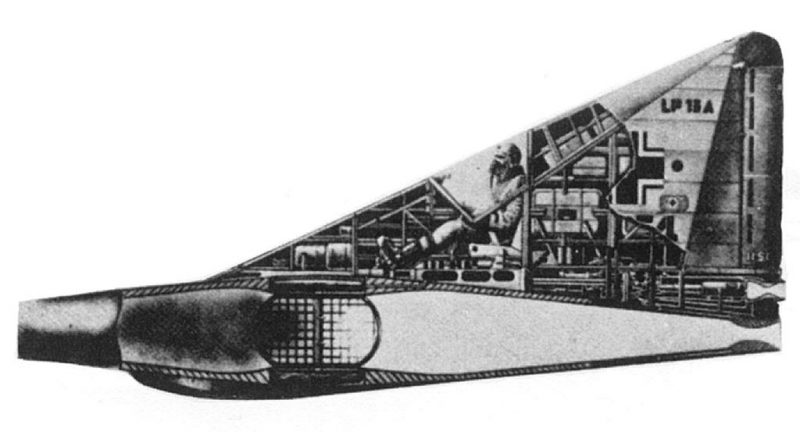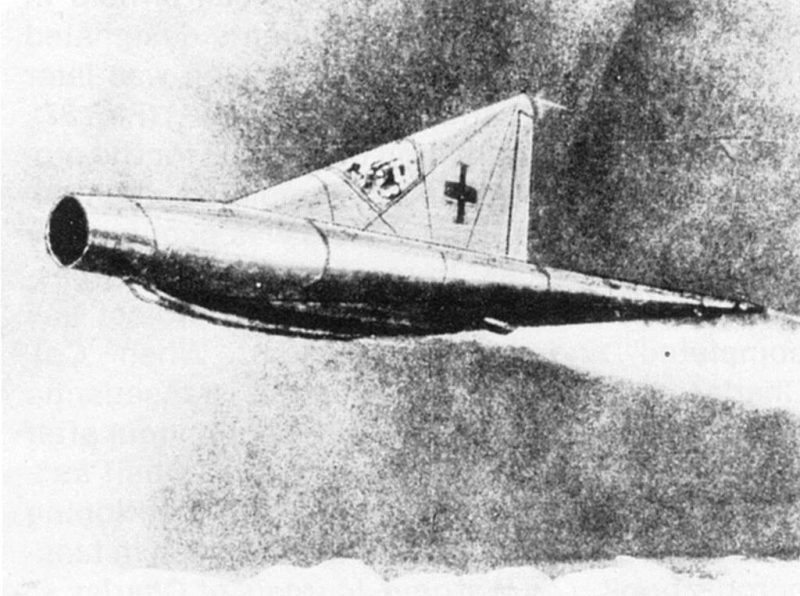
As conventional fuels were in extremely short supply by late 1944, Lippisch proposed that the P.13a be powered by coal. Initially, it was proposed that a wire-mesh basket holding coal be mounted behind a nose air intake, protruding slightly into the airflow and ignited by a gas burner.
The last desperate attempts by the Luftwaffe to stop the Allied bomber streams were exemplified by the demand: fighters, fighters, fighters – quick and simple to build, cheap and from easily accessible materials, small dimensions, superior speed compared to enemy escort fighters and firepower. Nearly all aircraft manufacturers and designers in the Third Reich put designs to paper along these lines. Even Dr. Lippisch’s ideas during the last year of the war fit into this concept. Of his numerous variants, the Lippisch 13a was actually given serious consideration.
It
was the end of the war that prevented further development beyond the un
powered DM-1 test glider. After the war, Lippisch, working with
American aircraft designer Convair, developed and tested the XF-92 based
on his designs, leading to the eventual adoption of the F-102 Delta
Dagger and its successor, the F-106 Delta Dart.
The little-known
Lippisch P.13B is one of the most controversial aircraft of the Second
World War – not due to any special paper project design discovered apart
from the others, but due to the fact that the United States has
deliberately kept classified documents (that may prove that THIS
aircraft was actually built in 1945 and was the first to break the sound
barrier) hidden. But first, a brief summary of its history.
As conventional fuels were in extremely short supply by late 1944, Lippisch proposed that the P.13a be powered by coal. Initially, it was proposed that a wire-mesh basket holding coal be mounted behind a nose air intake, protruding slightly into the airflow and ignited by a gas burner. Following wind-tunnel testing of the ramjet and the coal basket, modifications were incorporated to provide more efficient combustion.
The coal was to take the form of small granules instead of irregular lumps, to produce a controlled and even burn, and the basket was altered to a mesh drum revolving on a vertical axis at 60 rpm. A jet of flame from tanks of bottled gas would fire into the basket once the P.13a had reached operating speed (above 320 km/h), whether by using a rocket to assist take off or by being towed.
The air passing through the ramjet would take the fumes from the burning coal towards the rear where they would mix under high pressure with clean air taken from a separate intake. The resulting mixture of gas would then be directed out through a rear nozzle to provide thrust. A burner and drum were built and tested successfully in Vienna by the design team before the end of the war.

The P13a was made of wood, plywood and
steel tubing. One-piece wing of open rib design, cantilever, vertical
and horizontal stabilizer surfaces were hinged, with trim tabs in the
interior portion. There was no fuselage in the normal sense, the cockpit
was located in part within the forward portion of the vertical
stabilizer, in part just behind the forward leading edge between the two
main spars.
A window in the lower forward floor
provided better view at high angles of attack (during landing at roughly
35 degrees). The triangular vertical stabilizer had a similar profile
as the wing. Trimming was accomplished by a manually operated water
transfer pump 9 gallons from a rear tank to a nose tank and back. The
tricycle landing gear, which could only be retracted on the ground, had a
23 inch travel stroke.
At the end of the war even the prototype
DM-1 test glider had not been finished when it was captured by US
forces. It was ordered to be completed by Lippisch’s team and was then
shipped to the USA where it was test-flown. According to NACA the
results were positive and lessons learned were incorporated into NASA’s
research aircraft of the 1950s and on.Film footage exists which shows a gliding test of a scaled-down model of the P.13a. These tests began in May 1944 at Spitzerberg, near Vienna.
Length: 22 ft
Wingspan: 19 ft 9 in
Height: 10 ft 8 in
Wing area: 215 ft²
Loaded weight: 5,060 lb
Powerplant: 1× Kronach
Lorin coal-burning ramjet


Δεν υπάρχουν σχόλια:
Δημοσίευση σχολίου